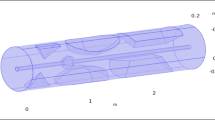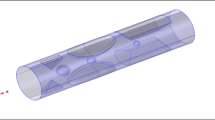Abstract
The human aorta is a high-risk area for vascular diseases, which are commonly restored by thoracic endovascular aortic repair. In this paper, we report a promising shear-activated targeted nanoparticle drug delivery strategy to assist in the treatment of coarctation of the aorta and aortic aneurysm. Idealized three-dimensional geometric models of coarctation of the aorta and aortic aneurysm are designed, respectively. The unique hemodynamic environment of the diseased aorta is used to improve nanoparticle drug delivery. Micro-carriers with nanoparticle drugs would be targeting activated to release nanoparticle drugs by local abnormal shear stress rate (SSR). Coarctation of the aorta provides a high SSR hemodynamic environment, while the aortic aneurysm is exposed to low SSR. We propose a method to calculate the SSR thresholds for the diseased aorta. Results show that the upstream near-wall area of the diseased location is an ideal injection location for the micro-carriers, which could be activated by the abnormal SSR. Released nanoparticle drugs would be successfully targeted delivered to the aortic diseased wall. Besides, the high diffusivity of the micro-carriers and nanoparticle drugs has a significant impact on the surface drug concentrations of the diseased aortic walls, especially for aortic aneurysms. This study preliminary demonstrates the feasibility of shear-activated targeted nanoparticle drug delivery in the treatment of aortic diseases and provides a theoretical basis for developing the drug delivery system and novel therapy.







Similar content being viewed by others
References:
Alastruey J, Xiao N, Fok H, Schaeffter T, Figueroa CA (2016) On the impact of modelling assumptions in multi-scale, subject-specific models of aortic haemodynamics. J R Soc Interface. https://doi.org/10.1098/rsif.2016.0073
Arzani A, Dyverfeldt P, Ebbers T, Shadden SC (2012) In vivo validation of numerical prediction for turbulence intensity in an aortic coarctation. Ann Biomed Eng 40:860–870. https://doi.org/10.1007/s10439-011-0447-6
Czerny M et al (2021) Current options and recommendations for the use of thoracic endovascular aortic repair in acute and chronic thoracic aortic disease: an expert consensus document of the European Society for Cardiology (ESC) Working Group of Cardiovascular Surgery, the ESC Working Group on Aorta and Peripheral Vascular Diseases, the European Association of Percutaneous Cardiovascular Interventions (EAPCI) of the ESC and the European Association for Cardio-Thoracic Surgery (EACTS). Eur J Cardiothorac Surg 59:65–73. https://doi.org/10.1093/ejcts/ezaa268
Ebrahimi S, Vatani P, Amani A, Shamloo A (2021) Drug delivery performance of nanocarriers based on adhesion and interaction for abdominal aortic aneurysm treatment. Int J Pharm 594:120153. https://doi.org/10.1016/j.ijpharm.2020.120153
Epshtein M, Korin N (2017) Shear targeted drug delivery to stenotic blood vessels. J Biomech 50:217–221. https://doi.org/10.1016/j.jbiomech.2016.11.015
Gijsen F, Allanic E, Van de Vosse F, Janssen J (1999) The influence of the non-Newtonian properties of blood on the flow in large arteries: unsteady flow in a 90 curved tube. J Biomech 32:705–713. https://doi.org/10.1016/S0021-9290(99)00014-7
Grief AD, Richardson G (2005) Mathematical modelling of magnetically targeted drug delivery. J Magn Magn Mater 293:455–463. https://doi.org/10.1016/j.jmmm.2005.02.040
Holme MN et al (2012) Shear-stress sensitive lenticular vesicles for targeted drug delivery. Nat Nanotechnol 7:536–543. https://doi.org/10.1038/nnano.2012.84
Kleinstreuer C, Feng Y, Childress E (2014) Drug-targeting methodologies with applications: a review. World Journal of Clinical Cases: WJCC 2:742
Korin N et al (2012) Shear-activated nanotherapeutics for drug targeting to obstructed blood vessels. Science 337:738–742
Lantz J, Ebbers T, Engvall J, Karlsson M (2013) Numerical and experimental assessment of turbulent kinetic energy in an aortic coarctation. J Biomech 46:1851–1858. https://doi.org/10.1016/j.jbiomech.2013.04.028
Lobatto ME, Fuster V, Fayad ZA, Mulder WJ (2011) Perspectives and opportunities for nanomedicine in the management of atherosclerosis. Nat Rev Drug Discovery 10:835–852
Marosfoi MG et al (2015) Shear-activated nanoparticle aggregates combined with temporary endovascular bypass to treat large vessel occlusion. Stroke 46:3507–3513
Meschi SS, Farghadan A, Arzani A (2021) Flow topology and targeted drug delivery in cardiovascular disease. J Biomech 119:110307. https://doi.org/10.1016/j.jbiomech.2021.110307
Pala R, Anju VT, Dyavaiah M, Busi S, Nauli SM (2020) Nanoparticle-mediated drug delivery for the treatment of cardiovascular diseases. Int J Nanomedicine 15:3741–3769. https://doi.org/10.2147/IJN.S250872
Pirola S, Cheng Z, Jarral OA, O’Regan DP, Pepper JR, Athanasiou T, Xu XY (2017) On the choice of outlet boundary conditions for patient-specific analysis of aortic flow using computational fluid dynamics. J Biomech 60:15–21. https://doi.org/10.1016/j.jbiomech.2017.06.005
Qiao Y, Mao L, Zhu T, Fan J, Luo K (2019a) Biomechanical implications of the fenestration structure after thoracic endovascular aortic repair. J Biomech 99:109478. https://doi.org/10.1016/j.jbiomech.2019.109478
Qiao Y, Zeng Y, Ding Y, Fan J, Luo K, Zhu T (2019b) Numerical simulation of two-phase non-Newtonian blood flow with fluid-structure interaction in aortic dissection. Comput Methods Biomech Biomed Eng 22:620–630. https://doi.org/10.1080/10255842.2019.1577398
Qiao Y, Mao L, Ding Y, Zhu T, Luo K, Fan J (2021) Fluid‐structure interaction: Insights into biomechanical implications of endograft after thoracic endovascular aortic repair. Comput Biol Med 138:104882. https://doi.org/10.1016/j.compbiomed.2021.104882
Tan FP, Soloperto G, Bashford S, Wood NB, Thom S, Hughes A, Xu XY (2008) Analysis of flow disturbance in a stenosed carotid artery bifurcation using two-equation transitional and turbulence models. J Biomech Eng 130:061008. https://doi.org/10.1115/1.2978992
Tan FPP, Borghi A, Mohiaddin RH, Wood NB, Thom S, Xu XY (2009) Analysis of flow patterns in a patient-specific thoracic aortic aneurysm model. Comput Struct 87:680–690. https://doi.org/10.1016/j.compstruc.2008.09.007
Tibbitt MW, Dahlman JE, Langer R (2016) Emerging frontiers in drug delivery. J Am Chem Soc 138:704–717
Acknowledgements
This research was supported by the National Postdoctoral Program for Innovative Talents (CN) [Grant Number BX20200290], Postdoctoral Science Foundation (CN) [Grant Number 2020M681852], Postdoctoral Science Foundation of Zhejiang Province (CN) [Grant Number ZJ2020153].
Author information
Authors and Affiliations
Corresponding authors
Ethics declarations
Conflict of interest
All authors declare that they have no conflicts of interest.
Additional information
Publisher's Note
Springer Nature remains neutral with regard to jurisdictional claims in published maps and institutional affiliations.
Rights and permissions
About this article
Cite this article
Qiao, Y., Wang, Y., Chen, Y. et al. Mathematical modeling of shear-activated targeted nanoparticle drug delivery for the treatment of aortic diseases. Biomech Model Mechanobiol 21, 221–230 (2022). https://doi.org/10.1007/s10237-021-01530-9
Received:
Accepted:
Published:
Issue Date:
DOI: https://doi.org/10.1007/s10237-021-01530-9




